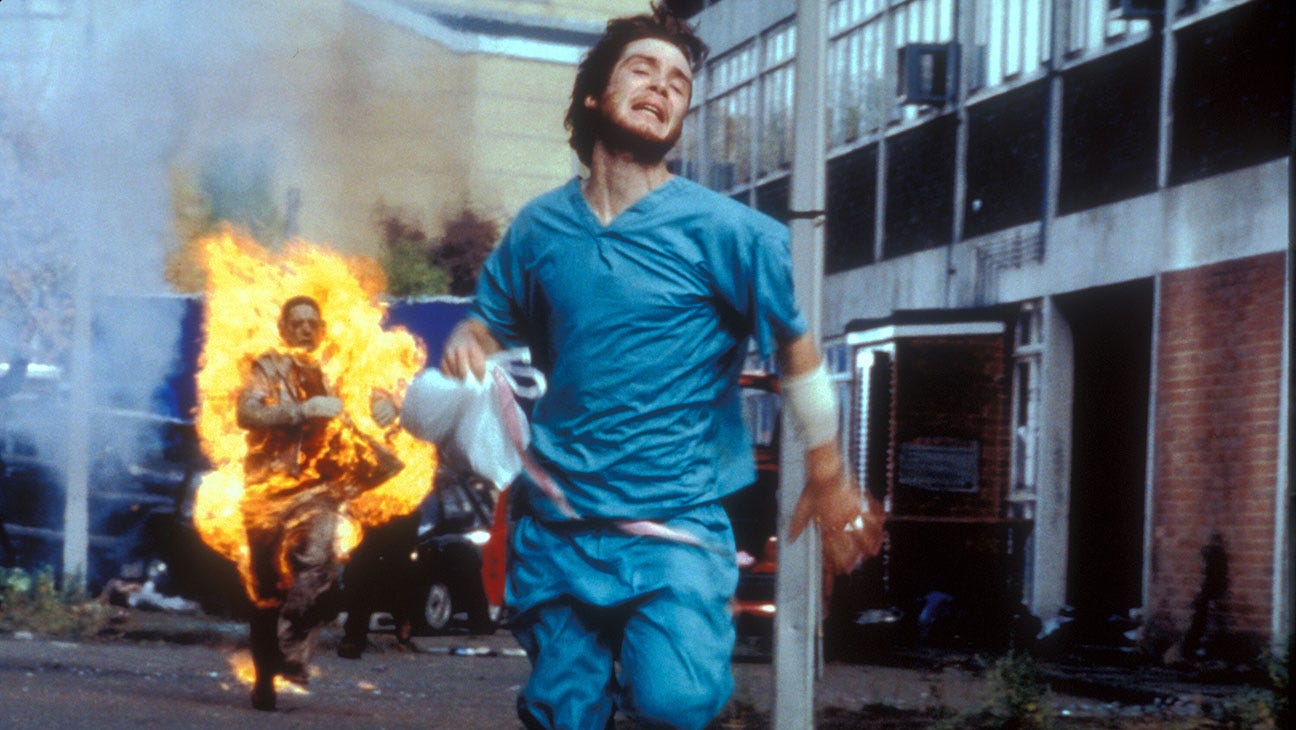How contagious is rage?
On its face, 28 Days Later is a simple zombie movie. A man wakes up alone in a dead world. A viral outbreak has turned the vast majority of the population into mindless killing machines. He teams up with a small band of survivors in search of some sort of future. All the tropes are there.
But that’s not how the movie opens. The movie opens with a test monkey being forced to watch multiple feeds of horrifying and distressing footage. Then we learn that it and the other chimps in the lab are actually infected with something.
“Infected with what?” asks an animal rights activist who has broken into the facility.
“Rage,” answers a frightened scientist.
The virus isn’t really elaborated upon any more than that (at least, not in this movie). All we know–all we need to know–is that mankind has fallen to Rage. It has gutted the streets, sacked the temples, and driven the few left uninfected into hiding.
Were this movie to be released today, it would feel a little on the nose, right? But it wasn’t. It was released over two decades ago. Two decades before the constant riots, mass shootings, and political assassinations. Were this to be released today, it would be borderline exploitative. A cash grab, making a dull and obvious point: People sure are angry today, huh?
But in 2002?
2002 was a year before the US and the UK invaded Iraq. And we were in Iraq for-ev-er. That’s how long ago this movie was made, which makes it something close to prophetic.
So what is there to say about it then? What is there to say about a movie that perfectly distilled our cultural moment 20 years before the moment happened?
Well, seeing as the third installment of the 28 (Insert Unit of Time) series has just hit theaters, I'd better think of something, right? So I guess we’re going to have to dig down a little deeper and see what two decades of hindsight has to offer.
Welcome to Hell
A lot of post-apocalyptic movies–specifically zombie movies–have been viewed through the theological lens of “oh, we’re in Hell now.” And it’s not hard to see why. In these scenarios, the world as we knew it has died. Our scientific hubris has finally made its bid for us. Everywhere we look, there is a weeping and gnashing of teeth.
28 Days Later does a particularly good job of this but not from the point of view of the survivors. Despite all of the screeching horror the movie has to offer, there is a surprisingly large amount of very human moments as well. Experiencing the mundane joy of shopping at the supermarket after being deprived of it for so long. Seeing a herd of wild horses gallop through the empty countryside. Sharing a rare kiss with a utilitarian nihilist in the ruins of an old monastery at the end of the world.
All good stuff here.
No, the real Hell on offer is what we know about the infected. They are full of rage, literally and figuratively. They are completely governed by their own appetites. And they are simultaneously isolated while also travelling in hordes.
Don’t get me wrong, this has always been the vision for the modern zombie. George Romero’s Dawn of the Dead brought this home about as succinctly as possible: a bunch of mindless shamblers haunting the glossy hallways of a shopping mall. An image of what happens when our thoughtless consumption reaches science-fiction heights.
But there’s something fresh and poignant about the zombies in 28 Days Later. They’re no longer lethargic and slow. They’re horrifically fast, which throws a big wet blanket on any misguided notion of “having fun” in a zombie apocalypse. Outrunning these creatures is never a sure thing.
The fact that this virus is a “rage” virus makes it distinct from other zombie viruses. This isn’t just spread through contact. There is something about rage and hopelessness that serves as a sort of onset for the infection. We see this very clearly when one of the characters, Frank, has his hopes dashed after finding the military stronghold he was planning on sheltering in has been overrun by the undead. He shouts at his fellow survivors and stomps off. Then, in a fit of thoughtless anger, he strikes a structure that results in a single drop of infected blood falling into his eye.
This one drop is enough to upend his whole life in seconds. Right before his daughter’s eyes, he transforms into an out-of-control monster, shouting and flailing at the air.
This clear line drawn between rage, the emotion, and Rage, the virus; serves as a reminder that rage is infectious. It transforms us into something those closest to us fail to recognize. And sometimes, when viewed through a theological lens, our rage is something we can’t come back from.
This might be hard for some folks, but as a Christian, I believe that whatever bitterness and resentment you refuse to let go of is something you drag into eternity with you. In some sense, it becomes you’re eternity.
I am of the opinion (and not all Christians will agree with this sentiment) that eternity is something we are experiencing now. That Heaven and Hell are right now as well as later on, and if we’re not building one then we’re building the other. I believe that our eternal lives are built out of the moments we chose to shelter in.
The scary thing about the Rage virus is that it’s irreversible. As modern secular folks, we often chafe against the idea of dying and going somewhere horrible that we can’t come back from. We don’t like the finality of it. We don’t like being held accountable for the rules of a game we haven’t even agreed to play.
Now I say “we” here very intentionally. This is something that I’ve chafed against in the past. I’ve often struggled with the idea of the irreconcilability of Hell. But I’m not talking about Hell as a proposition right now. I’m not trying to argue whether the idea is “fair” or “unfair” by some modern standard. I’m more concerned about it as a spiritual reality. As a way of being.
Because I feel like we all know people that are in Hell right now at this very moment, right? We all know living, breathing, walking-around folk who are so consumed by bitterness and rage that they’re practically unreachable. They look at you through a kind of fog, hearing but not hearing. Seeing but not seeing.
This is the thing made manifest by the Rage virus. Once people are lost to it then it often feels like they are truly lost to it. Like there’s no reasoning with them. No convincing them otherwise.
And that’s what Hell is. Hell is that wretched isolation among the horde that is so evident in the image of the zombie. It’s being alone while with others. It’s a way of keeping a tight ball of hatred inside of you with nothing with which to unravel it. A hunger that you can’t satisfy. A gnawing feeling you can’t just push to the back of your mind or shrug off.
In his book, The Great Divorce, C.S. Lewis describes it like this:
"The whole difficulty of understanding Hell is that the thing to be understood is so nearly Nothing. But ye'll have had experiences . . . it begins with a grumbling mood, and yourself still distinct from it: perhaps criticising it. And yourself, in a dark hour, may will that mood, embrace it. Ye can repent and come out of it again. But there may come a day when you can do that no longer. Then there will be no you left to criticise the mood, nor even to enjoy it, but just the grumble itself going on forever like a machine.”
Holy and Unholy Anger
The interesting thing about the zombies in 28 Days Later is that the film takes the emotion of rage and makes it synonymous with hunger. Anger is folded into the insatiable appetite that drives the monsters’ actions.
In other words, rage is an appetite. And it’s our appetites that get on top of us. It’s our appetites that wrestle our better natures towards wayward things. Learning to control one’s own appetites is one of the great Christian projects.
Galatians 5:17 says:
“For the desires of the flesh are against the Spirit, and the desires of the Spirit are against the flesh, for these are opposed to each other, to keep you from doing the things you want to do.”
The word “Spirit” here isn’t talking about some ethereal cloud inside you or above you in the sky. The word “Spirit” might be better understood as a source of unification, both in how one’s own spirit unites the individual pieces and cells and atoms of their body, and in how they as individuals become united with the larger body of Christ.
1 Corinthians 12:12-14 says
There is one body, but it has many parts. But all its many parts make up one body. It is the same with Christ. We were all baptized by one Holy Spirit. And so we are formed into one body. It didn’t matter whether we were Jews or Gentiles, slaves or free people. We were all given the same Spirit to drink. So the body is not made up of just one part. It has many parts.
When we are governed by our appetites, we get knocked askew. Our bodies, whether they are our own physical bodies or the larger bodies of the communities we participate in, are put at risk. At risk of coming apart. If the “spirit” of something unites, then it is our wayward impulses that disintegrate. When our appetites take the proverbial wheel of our lives, we don’t pursue the things we ought to pursue. We don’t see things the way they should be seen or treat them the way they should be treated.
When we are being steered around by the appetite of “rage” we punch holes in the wall, we utter cutting words to those we love, and our ability to hope and discern the good moments from the bad ones begins to suffocate us until all of our moments are simply bad.
In other words: when we are governed by rage, things fall apart.
But is anger always wrong? Isn’t there a good kind of rage? Is there some way to embody that same rage that Christ embodies when he drives the moneylenders from the temple?
I think we get an answer at the end of 28 Days Later. In a time of need, our main character, Jim, experiences a sort of rage as well. He’s not infected in a literal sense but he embodies a sort of righteous anger–even viciousness–to drive a group of brutal and nihilistic soldiers from their stronghold and save his companions.
He is so unrecognizable in his rage that Selena, one of the people he seeks to save, mistakes him for one of the infected and nearly takes his head off. But, lucky for him, he is able to calm down and show that he hasn’t turned. He has control of his appetite; it’s not in control of him.
He is also able to shed that holy rage once the villains are defeated and the film finally draws to a close.
Hello
A constant refrain of the movie is the word “hello.” The film opens with Jim walking around a deserted city, uttering his flacid greeting in hesitant confusion. He wanders into a church and says “hello” to a mass of dead bodies (some of which aren’t all the way dead).
Later on, after Jim has met some survivors and has a better grip on the situation, he casts an almost rebellious sounding “hello” into the darkness of an abandoned building, which is soon met by the rage-filled cries of an infected child.
Then, finally, after Jim has passed through the fire of his current ordeal, rejected nihilism, and embraced hope; he joins the other survivors in using linens to spell out a huge “hello” on a green hillside, in hopes that someone else might see the beacon and carry them away to safety.
And we notice here that this “hello” isn’t one that is coming from a solitary individual. It’s coming from a collective. A group. A community. A found family. Jim hasn’t found hope in himself but in others. If “the devil’s game is one-on-one,” as is often said, then the antidote is found in the warm embrace of community and fellowship, which is a far cry from the moaning and gnashing teeth of the infected horde.
When anger is put in its proper place and used to defend life instead of consuming it, then the “Hell” of our ravenous and bloodthirsty world might just make a little space for a warm and reasoned “Hello.”







28 Days Later was a brilliant and thoughtful film. Romero was also "on the nose" but retrospectively prophetic—the characters dying because they're too busy filming everything in Land of the Dead (a full 2 years before the iPhone!) is eery. That character died like an Influencer would. It also reminds me a lot of the ending of the Simpsons episode "Homer Badman." Homer is exonerated of groping a young woman by Groundskeeper Willy's video voyeurism. Marge says: "The courts might not work anymore, but as long as everybody is videotaping everyone else, justice will be done!" This premiered in 1994.
All of this to me suggests the prophetic powers of great art and artists. They see the ripples before the wave.
As it relates to 28 days later (UK premier 2002, US premier 2003) it's the first ripples of how a "War with No Enemy" leads to rage with no target—in our case, 9/11 directly led to the war in Iraq despite Iraq's lack of involvement in the attacks. It's anger at the world that later becomes attributed to the alleged source(s) of the state of the world. People talk about Trump and 2020 as the source of the present dissatisfaction in American culture; I place it in the shattering of American hopefulness of 9/11 which led to a war with no enemy ("terror itself" doesn't count because it's unkillable) which led to a further shattering of institutional trust which tilled the soil for an economic shattering of trust that was Occupy Wallstreet—and that signified something like a formal vote of no confidence in America by many young people.
Rage against concepts always ends up turning into rage against each other because we're the only physical objects in which it can be divested with some physical result. Which, I think, is a big part of what's being said here what the original 28 Days Later was prophetically warning us about before all this manifested in real life.